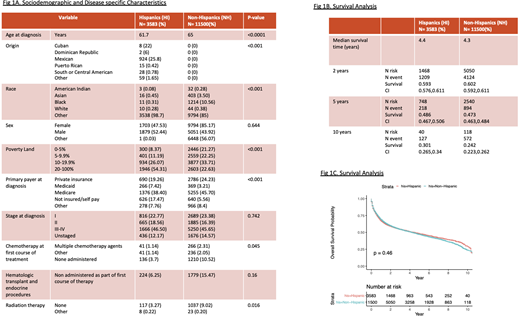BACKGROUND:
Diffuse Large B Cell Lymphoma (DLBCL) is the most common and most aggressive subtype of Non-Hodgkin Lymphoma. (Blood PMID: 9166827) Despite significant advances, treatment survival remains heterogenous due to biologic differences and perhaps ethnic and racial disparities. Multiple epidemiological studies have evaluated racial differences, mainly comparing African Americans (AA) with Non-Hispanic (NH), showing AA patients have a 10-20% higher risk of death. (BMC PMID: 21073707, Leuk PMID: 22800091, Cancer PMID: 24048801) A recent study showed how socioeconomic factors also influence patient survival and this can be linked to racial differences as well. (Blood PMID: 24705494). Small sample studies have characterized DLBCL in Hispanics (HI) but no definite conclusions have been drawn. (ASH Blood 2018 132:4867, JCO 10.1200, Blood (2019) 134 (Supplement_1): 2916). The need of larger studies to characterize survival differences establishes the basis of our population-based analysis in Texas comparing DLBCL in HI vs NH.
METHODS:
This is a retrospective study of a cohort of patients diagnosed with lymphoma from the Texas Cancer Registry (TCR) database. Patients with DLBCL diagnosed from 2006 to 2016 were identified by the International Classification of Diseases for Oncology Third Edition (ICD-O-3) code list. Standard demographic variables collected include gender, race, ethnicity, birthplace, occupation, dates at diagnosis and death, primary payer at diagnosis, subtype of lymphoma, stage, type of treatment, poverty index, and vitality status among others. Categorical outcomes were summarized with frequencies and percentages and age (years) was the only continuously distributed outcome with the mean and standard deviation. The significance of variation in the distribution of categorical outcomes with ethnicity (HI, NH) was assessed with Fisher's Exact tests or Pearson's Chi-square tests as appropriate; age was assessed with T-tests or Wilcoxon tests as appropriate. Survival time was measured in years from date of primary diagnosis to date of death. Patients not coded as dead were considered censored on survival time at the date last seen. Survival distributions were described with Kaplan-Meier curves and significance of variation in median survival with ethnicity was assessed with log rank testing. At risk tables were computed based on the Kaplan-Meier estimate of the survival curve. All statistical testing was two-sided with a significance level of 5%.
RESULTS:
A total of 15,083 patients met inclusion criteria, with 3583 HI and 11500 NH diagnosed with DLBCL from 2006 to 2016. Demographic data was analyzed and compared between both groups, (Fig 1A). The median age of diagnosis was 61.7 on HI population and 65 on the NH. Among the HI population most of the patients were of Mexican origin (25%). HI have a higher percentage (24%) of non-insured or Medicaid than NH (8%) with a significant p value of <0.001 and a statistically significant higher poverty index within HI with 54% living on a 20-100% poverty land. Staging was similar between both groups. Most of the patients, 46% of HI and 45% of NH, have a stage III-IV grade DLBCL. The NH population received more treatment with chemotherapy 4% compared to 2% of the HI group, but this difference was not statistically significant. Both groups received similar treatments with bone marrow transplant, or radiation.
The median survival time was similar between HI and NH, 4.4 and 4.3 years respectively. Survival probability at 2, 5 and 10 years for HI was 0.59 (CI 0.576,0.611), 0.48 (CI 0.467, 0.506) and 0.301 (CI 0.265,0.34) respectively. For NH the survival probability was similar, 0.602 (CI 0.592,0.611), 0.473 (CI 0.463,0484) and 0.242 (CI 0.223,0.262) respectively (Fig 1B). The overall survival probability at 10 years did not show a statistically significant difference for HI vs NH (p-value 0.46) (Fig 1C).
CONCLUSION.
Despite demographic disparities between HI and NH, and statistically significant differences with more HI patients uninsured and a higher index of poverty land; there was no significant distinction in overall survival in patients with DLBCL. The findings suggest no impact of ethnicity to that regard.
Diaz Duque:ADCT Therapeutics: Research Funding; Molecular Templates: Research Funding; AstraZeneca: Research Funding; Hutchinson Pharmaceuticals: Research Funding; Seattle Genetics: Speakers Bureau; Verastem: Speakers Bureau; AbbVie: Speakers Bureau.
Author notes
Asterisk with author names denotes non-ASH members.


This feature is available to Subscribers Only
Sign In or Create an Account Close Modal